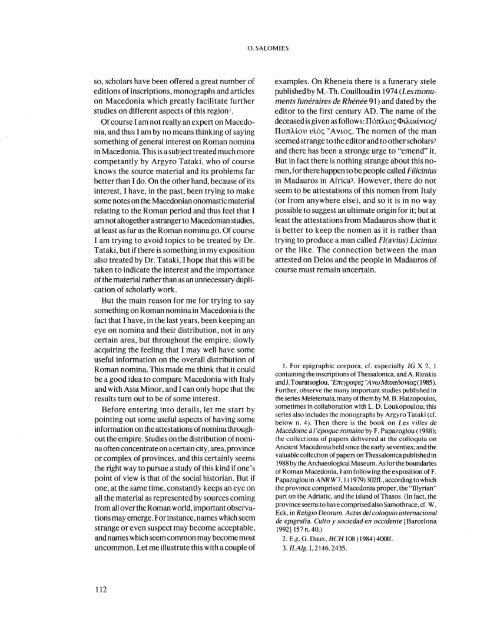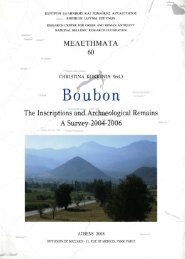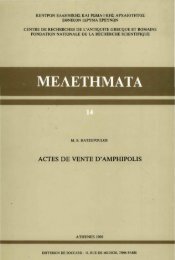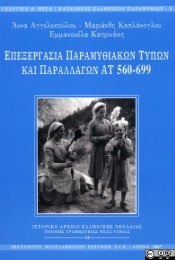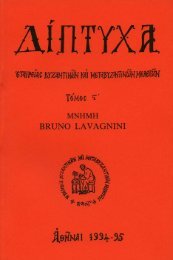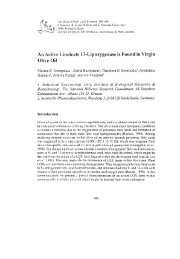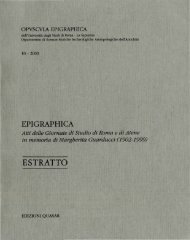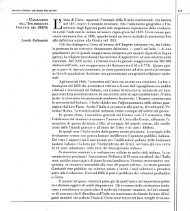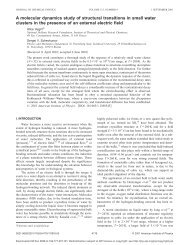Roman onomastics in the Greek East: social and political aspects ...
Roman onomastics in the Greek East: social and political aspects ...
Roman onomastics in the Greek East: social and political aspects ...
You also want an ePaper? Increase the reach of your titles
YUMPU automatically turns print PDFs into web optimized ePapers that Google loves.
so, scholars have been offered a great number of<br />
editions of <strong>in</strong>scriptions, monographs <strong>and</strong> articles<br />
on Macedonia which greatly facilitate fur<strong>the</strong>r<br />
studies on different <strong>aspects</strong> of this region 1 .<br />
Of course I am not really an expert on Macedonia,<br />
<strong>and</strong> thus I am by no means th<strong>in</strong>k<strong>in</strong>g of say<strong>in</strong>g<br />
someth<strong>in</strong>g of general <strong>in</strong>terest on <strong>Roman</strong> nom<strong>in</strong>a<br />
<strong>in</strong> Macedonia. This is a subject treated much more<br />
competantly by Argyro Tataki, who of course<br />
knows <strong>the</strong> source material <strong>and</strong> its problems far<br />
better than I do. On <strong>the</strong> o<strong>the</strong>r h<strong>and</strong>, because of its<br />
<strong>in</strong>terest, I have, <strong>in</strong> <strong>the</strong> past, been try<strong>in</strong>g to make<br />
some notes on <strong>the</strong> Macedonian onomastic material<br />
relat<strong>in</strong>g to <strong>the</strong> <strong>Roman</strong> period <strong>and</strong> thus feel that I<br />
am not altoge<strong>the</strong>r astrangerto Macedonian studies,<br />
at least as far as <strong>the</strong> <strong>Roman</strong> nom<strong>in</strong>a go. Of course<br />
I am try<strong>in</strong>g to avoid topics to be treated by Dr.<br />
Tataki, but if <strong>the</strong>re is someth<strong>in</strong>g <strong>in</strong> my exposition<br />
also treated by Dr. Tataki, I hope that this will be<br />
taken to <strong>in</strong>dicate <strong>the</strong> <strong>in</strong>terest <strong>and</strong> <strong>the</strong> importance<br />
of <strong>the</strong> material ra<strong>the</strong>r than as an unnecessary duplication<br />
of scholarly work.<br />
But <strong>the</strong> ma<strong>in</strong> reason for me for try<strong>in</strong>g to say<br />
someth<strong>in</strong>g on <strong>Roman</strong> nom<strong>in</strong>a <strong>in</strong> Macedonia is <strong>the</strong><br />
fact that I have, <strong>in</strong> <strong>the</strong> last years, been keep<strong>in</strong>g an<br />
eye on nom<strong>in</strong>a <strong>and</strong> <strong>the</strong>ir distribution, not <strong>in</strong> any<br />
certa<strong>in</strong> area, but throughout <strong>the</strong> empire, slowly<br />
acquir<strong>in</strong>g <strong>the</strong> feel<strong>in</strong>g that I may well have some<br />
useful <strong>in</strong>formation on <strong>the</strong> overall distribution of<br />
<strong>Roman</strong> nom<strong>in</strong>a. This made me th<strong>in</strong>k that it could<br />
be a good idea to compare Macedonia with Italy<br />
<strong>and</strong> with Asia M<strong>in</strong>or, <strong>and</strong> I can only hope that <strong>the</strong><br />
results turn out to be of some <strong>in</strong>terest.<br />
Before enter<strong>in</strong>g <strong>in</strong>to details, let me start by<br />
po<strong>in</strong>t<strong>in</strong>g out some useful <strong>aspects</strong> of hav<strong>in</strong>g some<br />
<strong>in</strong>formation on <strong>the</strong> attestations of nom<strong>in</strong>a throughout<br />
<strong>the</strong> empire. Studies on <strong>the</strong> distribution of nom<strong>in</strong>a<br />
often concentrate on a certa<strong>in</strong> city, area, prov<strong>in</strong>ce<br />
or complex of prov<strong>in</strong>ces, <strong>and</strong> this certa<strong>in</strong>ly seems<br />
<strong>the</strong>right way to pursue a study of this k<strong>in</strong>d if one's<br />
po<strong>in</strong>t of view is that of <strong>the</strong> <strong>social</strong> historian. But if<br />
one, at <strong>the</strong> same time, constantly keeps an eye on<br />
all <strong>the</strong> material as represented by sources com<strong>in</strong>g<br />
from all over <strong>the</strong> <strong>Roman</strong> world, important observations<br />
may emerge. For <strong>in</strong>stance, names which seem<br />
strange or even suspect may become acceptable,<br />
<strong>and</strong> names which seem common may become most<br />
uncommon. Let me illustrate this with a couple of<br />
112<br />
Ο. SALOMIES<br />
examples. On Rheneia <strong>the</strong>re is a funerary stele<br />
published by M.-Th. Couilloud<strong>in</strong> 1974 (Les monuments<br />
funéraires de Rhénée 91 ) <strong>and</strong> dated by <strong>the</strong><br />
editor to <strong>the</strong> first century AD. The name of <strong>the</strong><br />
deceased is given as follows : Πόπλιος Φιλικίνιος/<br />
Ποπλίου υιός "Ανιος. The nomen of <strong>the</strong> man<br />
seemed strange to <strong>the</strong> editor <strong>and</strong> to o<strong>the</strong>r scholars 2<br />
<strong>and</strong> <strong>the</strong>re has been a strenge urge to "emend" it.<br />
But <strong>in</strong> fact <strong>the</strong>re is noth<strong>in</strong>g strange about this nomen,<br />
for <strong>the</strong>re happen to be people called Filic<strong>in</strong>ius<br />
<strong>in</strong> Madauros <strong>in</strong> Africa 3 . However, <strong>the</strong>re do not<br />
seem to be attestations of this nomen from Italy<br />
(or from anywhere else), <strong>and</strong> so it is <strong>in</strong> no way<br />
possible to suggest an ultimate orig<strong>in</strong> for it; but at<br />
least <strong>the</strong> attestations from Madauros show that it<br />
is better to keep <strong>the</strong> nomen as it is ra<strong>the</strong>r than<br />
try<strong>in</strong>g to produce a man called Fl(avius) Lic<strong>in</strong>ius<br />
or <strong>the</strong> like. The connection between <strong>the</strong> man<br />
attested on Delos <strong>and</strong> <strong>the</strong> people <strong>in</strong> Madauros of<br />
course must rema<strong>in</strong> uncerta<strong>in</strong>.<br />
1. For epigraphic corpora, cf. especially IGX2, 1<br />
conta<strong>in</strong><strong>in</strong>g <strong>the</strong> <strong>in</strong>scriptions of Thessalonica, <strong>and</strong> A. Rizakis<br />
<strong>and</strong>J.Touratsoglou, 'Επιγραφές ΆνωΜακεδονίας(1985).<br />
Fur<strong>the</strong>r, observe <strong>the</strong> many important studies published <strong>in</strong><br />
<strong>the</strong> series Meletemata, many of <strong>the</strong>m by Μ. B. Hatzopoulos,<br />
sometimes <strong>in</strong> collaboration with L. D. Loukopoulou; this<br />
series also <strong>in</strong>cludes <strong>the</strong> monographs by Argyro Tataki (cf.<br />
below n. 4). Then <strong>the</strong>re is <strong>the</strong> book on Les villes de<br />
Macédo<strong>in</strong>e à l'époque roma<strong>in</strong>e by F. Papazoglou ( 1988);<br />
<strong>the</strong> collections of papers delivered at <strong>the</strong> colloquia on<br />
Ancient Macedonia held s<strong>in</strong>ce <strong>the</strong> early seventies; <strong>and</strong> <strong>the</strong><br />
valuable collection of papers on Thessalonica published <strong>in</strong><br />
1988 by <strong>the</strong> Archaeological Museum. As for <strong>the</strong> boundaries<br />
of <strong>Roman</strong> Macedonia, I am follow<strong>in</strong>g <strong>the</strong> exposition of F.<br />
Papazoglou <strong>in</strong> ANR Wl,l(\ 979) 302ff., accord<strong>in</strong>g to which<br />
<strong>the</strong> prov<strong>in</strong>ce comprised Macedonia proper, <strong>the</strong> "Illyrian"<br />
part on <strong>the</strong> Adriatic, <strong>and</strong> <strong>the</strong> isl<strong>and</strong> of Thasos. (In fact, <strong>the</strong><br />
prov<strong>in</strong>ce seems to have comprised also Samothrace, cf. W.<br />
Eck, <strong>in</strong> Religio Deorum. Adas del coloquio <strong>in</strong>ternacional<br />
de epigrafia. Culto y sociedad en occidente [Barcelona<br />
1992] 157 η. 40.)<br />
2. E.g. G. Daux, BCH WS (1984)400ff.<br />
3. ILAIg. 1,2146.2435.


